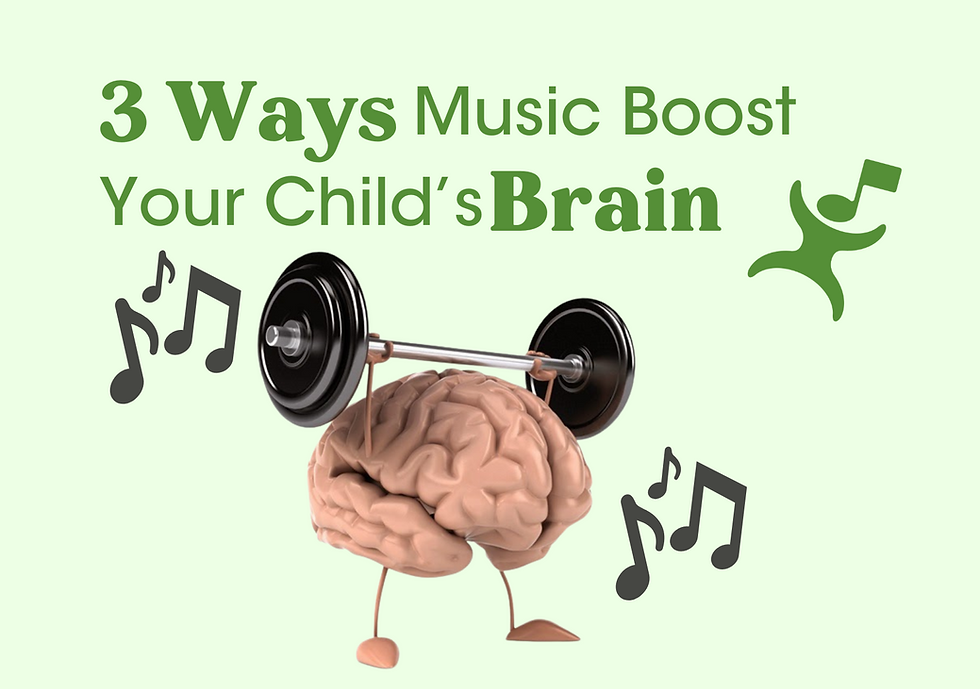Three Ways Music Boosts Your Child's Brain
- Let's Play Music

- Aug 23, 2024
- 2 min read
Updated: Sep 17

How does Let’s Play Music fit into all this brain-building activity? This program is so comprehensive in its musical scope that it builds the three areas of the brain most needed for learning: (1) the auditory cortex, (2) the visual/spatial cortex, and (3) the motor cortex. Let’s talk about each area and how it relates to learning.
Brain-Builder #1: Music strengthens the auditory cortex, enhancing reading and language skills.

Did you know the auditory cortex is five times smaller than the visual cortex? This means we generally learn faster and more effectively through visual means. However, when learning to read, children first rely on their ears to hear the pronunciation of words before using their eyes to recognize them.
Scientists have found that learning a musical instrument strengthens the auditory cortex, which enhances a child's ability to read, follow directions, and process information. This is particularly beneficial for children with learning disabilities, as many issues start with auditory processing.
Let's Play Music incorporates the Kodály method, which strengthens the auditory cortex through techniques like solfege and hand signs. This training helps children develop their aural skills by exposing them to varying pitches, rhythms, and harmonies. As a result, skills such as reading, writing, and information processing are significantly improved, making Let's Play Music a powerful tool for cognitive development.
Brain-Builder #2: Music strengthens the visual/spatial cortex, aiding in math and science.

Music training enhances the brain's visual/spatial areas, which are essential for problem solving, creativity, and grasping complex concepts in math and science.
For example, Albert Einstein had larger visual/spatial areas than most people, and he was also an accomplished violinist. He credited music with helping him solve intricate theories and problems, often finding inspiration and solutions while playing the violin.
Research supports this connection, showing that learning a musical instrument develops these spatial brain areas, making it easier for children to understand STEM fields (science, technology, engineering, and math). This development primes and prepares the brain for more advanced learning and problem-solving in these areas.
Brain-Builder #3: Music strengthens motor areas, enhancing brain organization and memory skills.

Learning a musical instrument and engaging in music significantly develops the brain's motor areas, which are vital for organizing the entire neurological system. Let’s Play Music incorporates the Orff-Shulwerk and Dalcroze methods to enhance these motor skills. In Orff-Shulwerk classes, children participate in rhythmic activities like drumming, clapping, stamping, and marching, which help organize the brain, improve focus, and boost memorization.
The Dalcroze method emphasizes eurhythmics, where children move to the beat of the music, integrating their senses of sight, hearing, and touch. This approach trains the body like an instrument and supports physical coordination, timing, and memory. Scientists agree that movement is crucial for learning and cognitive development. Engaging in musical activities such as dancing, marching, singing, and humming enhances language skills, listening abilities, and motor functions.
In summary, music education fosters brain development, enhances reading and language skills, improves memory, aids in math and science learning, and refines motor skills. It contributes to overall cognitive growth and well-being while being an enjoyable and rewarding experience.
And if you're ready to join a class teaching amazing musical skills, find a Let's Play Music teacher near you now!



Comments